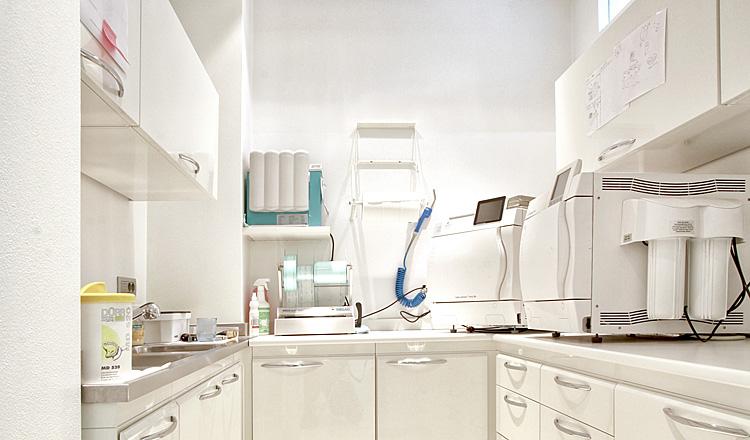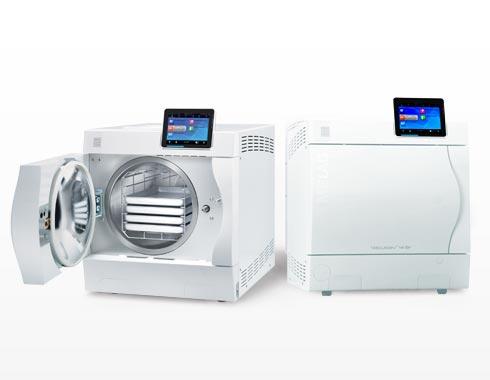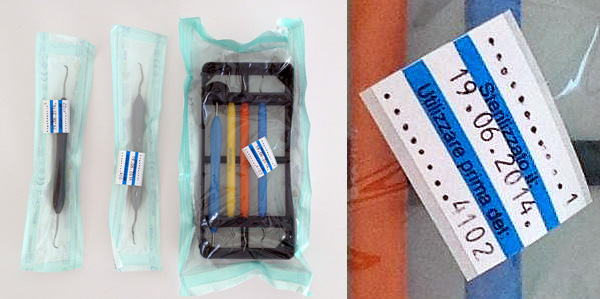 The main purpose of sterilization is to guarantee devices and materials which are safe when used on the patient. The full protection of both the patient and the operators who are evolved in the operation and therefore run the risk of infection or microbe transmission (cross infections) requires the steady application of strict decontamination protocols as well as of the highest standards of sterilization, which together with the professional ethics of our staff and the specific products, machines and control tests allows to our patients to peacefully undergo the therapy.
The main purpose of sterilization is to guarantee devices and materials which are safe when used on the patient. The full protection of both the patient and the operators who are evolved in the operation and therefore run the risk of infection or microbe transmission (cross infections) requires the steady application of strict decontamination protocols as well as of the highest standards of sterilization, which together with the professional ethics of our staff and the specific products, machines and control tests allows to our patients to peacefully undergo the therapy.
The need to work in a “protected” outpatient environment, which guarantees the correct sterilization of the tools, is a present, urgent problem.
Dentistry is a branch of the medical science, therefore procedures and organization of the clinic must guarantee the essential sterilization level for controlling infections.
Each tool that comes in contact with mucosa and enzymatic liquids (saliva, blood, pus) runs a high infection risk. In order to avoid this after each health service these tools are treated to avoid any infection risk.
Tool sterilization is no doubt a preventative and protection measure according to the Decree Law 626/1994 about safety in the work environment. As a matter of fact, the sterilization of the tools is a way to protect not only the workers (for example the dental assistants) who handle such tools every day and run therefore a cross infection risk but also the health of the patients who are treated in the clinic.
The sterilization obligation is also imposed on dentists by law according to the Ministerial Decree 28/09/1990 by the Ministry of Health about the “Rules about the protection of professionals against HIV infection ”. This decree orders: “Tools, handpieces, ultrasound removers, syringes, cutters and any other tool which gets in contact with the mucosa, if reusable, must be sterilized after being used for a patient”.
This rule states the obligation to sterilize the tools but mentions the devices too, which must be sterilized before being used with another patient.
Therefore, sterilization is the mainstay of the dental clinic and not simply an added value. It is the basis of the dental clinic. The actual added value is the technological update through the application of modern, advanced technologies that give more guarantees and high safety.
In our centre the traceability of all the sterilization processes is guaranteed by marking each sterile bag with 3 identification numbers:
–operator number
– date
– sterilization cycles
How are the tools at the dentist’s sterilized?
First of all tools are mechanically cleaned after being immersed in special cleaning solutions and disinfectants for the safety of the people that are in charge of their manipulation.
When the tools are dry they are put in special plastic bags, which are sealed through a packaging machine and allow to keep sterility until they are used.
These bags contain also sterilization markers, which are a further guarantee for the patient. The actual sterilization is carried out through autoclaves of the latest generation (MELAG 40B – MELAG 44B), where the packed tools are sterilized through a dump stream at 135 C° for 15 minutes at a pressure of 2 atmospheres. A microchip automatically checks temperatures, times and pressures. This control guarantees that the cycle constantly guarantees the sterilization of the tools.
Our clinic has got two autoclaves. So we can always use packed, sterile tools, also for a control check. The whole cleaning, disinfection and sterilization procedure takes place in a dedicated room.
After leaving the waiting room the patient enters the “operation area”, where the infection risk is higher than in the waiting room. Here he sits in one of our “armchairs”, where he is treated according to his needs.
Each operative room has previously been fully disinfected: floors, working surfaces, operative and surgical areas and furniture (operator chairs, cupboards, trolleys, etc.).
The centralized water and intake plant as well as the dentist chair water and intake plant frequently undergo a special treatment to minimize the bacterial charge, for example through the introduction of enzymatic disinfectants and cleaning substances containing ammonium, alkylamine, quaternary, anti-foaming agents, etc. into the circuits.
The central and peripheral filters are daily emptied and cleaned.
The clinic has got a wide range of disposable materials such as saliva ejectors, towels for the shelves and for the patient, cups, gloves, masks, operating gowns, headcaps, shoe covers, etc.
The operators are particularly careful not to touch what is around them, unless it is strictly necessary, in order to avoid any infection of the area out of the treatment area.
We all, from the doctors to the assistants, included the dental technician, who often works with us and give us his opinion about solutions and strategies in his area of expertise, are always particularly careful about all these aspects when doing our own service, be it simple or complex.
After each treatment and before the next one (with a new patient) we get ready for the next treatment as follows:
The assistants wear protection gloves and remove all the disposable objects and the polyethylene films and throw them in a container for special waste.
Then they disinfect the dentist chair vacuum system as described before and spray a ready-to-use solution containing quaternary ammonium and alcohol on all the surfaces of the operating area and let it work for some minutes before cleaning all the surfaces.
On the other hand, the tools and devices which can be used again undergo the following processes:
1. DECONTAMINATION – They are put into a bowl which is full of a 2% glutaraldehyde solution and lay on a working surface called “dirt area” in the sterilization room.
2. RINSING – The tools are held for a little time under a strong jet of water.
3. WASHING – It is made by hand by using an ultrasonic tank full of a disinfectant cleaner containing peracetic acid.
4. RINSING AND DRYING – At this step also the condition and the wear degree of the tools are checked.
5. PACKAGING – Now the dental tools are on the working surface called “clean” and are ready to be packed, one by one or as a set, in paper/film sterile bags. This packaging is essential to keep the tools sterile until they are used with the next patient. Therefore they are packed, sealed, dated and put into an autoclave, where they are sterilized.
 6. STERILIZATION – There are two autoclaves, both Class B, which means that they can carry out a perfect sterilization also of the inner parts, which cannot be dismantled, of all the tools, included the mechanical ones such as handpieces and turbines (the famous dentist’s drill).
6. STERILIZATION – There are two autoclaves, both Class B, which means that they can carry out a perfect sterilization also of the inner parts, which cannot be dismantled, of all the tools, included the mechanical ones such as handpieces and turbines (the famous dentist’s drill).
A very important aspect: the TRACEABILITY of the sterilization batch. This is recorded in the “sterility register”, where the sterilization date, the autoclave which has been used for that cycle and, if more sterilization cycles are carried out on the same day, the sequence number of the cycle are mentioned too. Here also the operator who carried out the process is identified through a number..
In the register the checks on the sterilization process effectiveness is recorded, too. These are:
– ON EACH BAG = Sterilization process MARKER: date+operator
– AT THE BEGINNING OF THE DAY= VAPOR-LINE (which states that the sterilization has been carried out) + TST charts.
– WEEKLY CHECK = HELIX TEST, which simulates the penetration of the steam in the hollow, porous cables.
– MONTHLY CHECK = BOWIE DICK TEST (test parcel), which detects the working defects and excludes the presence of air bubbles.
– MONTHLY CHECK = biologic proof that the sterilization has been carried out

